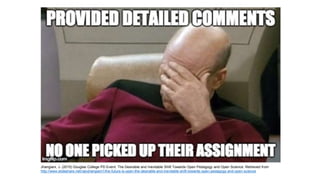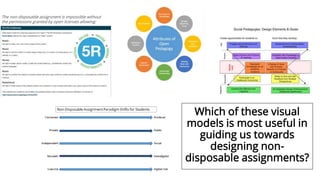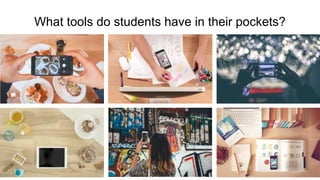The Non-Disposable Assignment: Enhancing Personalised Learning - Session 1
- 1. The Non-Disposable Assignment: Enhancing Personalized Learning Michael Paskevicius & Liesel Knaack Centre for Innovation and Excellence in Learning
- 2. Agenda Welcome and orientation (5 minutes) Brainstorm and discussion: What makes an assignment memorable, meaningful, and important (10 minutes) Overview of the disposable assignment and student centred learning (15 minutes) Activity: Examining the models for non-disposable assignments (10 minutes) What tools are available? (5 minutes) Examples from the wild and faculty reflections (10 minutes) Introducing our live reflection space (5 minutes) Activity (think pair share) and discussion: strengths, weaknesses, opportunities, and threats to this approach? (10 minutes) Next steps, deliverables, and questions (15 minutes)
- 3. Think back to an assignment you did while in school (at any level) that you still remember as significant and positive? Write down two keywords which describe that assignment
- 4. The Disposable Assignment What if we changed these “disposable assignments” into activities which actually added value to the world? Then students and faculty might feel different about the time and effort they invested in them. I have seen time and again that they do feel different about the efforts they make under these circumstances. These are assignments that students complain about doing and faculty complain about grading. They’re assignments that add no value to the world – after a student spends three hours creating it, a teacher spends 30 minutes grading it, and then the student throws it away. (Wiley, 2013)
- 5. Jhangiani, J. (2015) Douglas College PD Event: The Desirable and Inevitable Shift Towards Open Pedagogy and Open Science. Retrieved from http://www.slideshare.net/rajivjhangiani1/the-future-is-open-the-desirable-and-inevitable-shift-towards-open-pedagogy-and-open-science
- 6. Which of these visual models is most useful in guiding us towards designing non- disposable assignments? The non-disposable assignment is impossible without the permissions granted by open licenses allowing:
- 7. Accessing and remixing legally reusable text, multimedia from the web to form creative projects and representations of learning Building reflective, connected, peer reviewed, and creative open projects Challenging students to engage real world audiences by participating in knowledge communities and social networks Challenging students to become an active producer of knowledge in the open
- 8. What tools are available locally? #MakeSlidesFunAgain
- 9. What tools do students have in their pockets?
- 10. Web-based tools to support personalization (heaps) Bower’s (2016) typology of Web 2.0 collaborative technologies http://bit.ly/WebToolsPersonalisation
- 11. Case studies Peer review and collaborative writing “raises the bar for them. If they’re writing just for me, and I don’t take this personally, they don’t put in sometimes quite as much effort as if their peers are going to read what they wrote. So it raises for some of them their level of engagement and motivation. I created a non-disposable visual portfolio for students to document and follow their progress as well as observe and contribute feedback to their peers. The goal was also to complete the course with a set of assignments that showcases their learning and outcomes in an accessible and visually appealing manner. Surprisingly user engagement was quite active with parents, friends, and people from other countries commenting on posts and starting interesting discussions. I think the students found that really rewarding that it went beyond the needs of meeting a course requirement.
- 12. Throughout our workshops you will be invited to reflect openly on our workshop website. Feel free to share thoughts on the non-disposable assignment, design considerations, useful resources, apprehensions, or ideas. https://wordpress.viu.ca/enhancingpersonalizedlearning/ #nondisposableviu
- 13. What strengths, weaknesses, opportunities, and threats come with this approach?
- 14. References Bower, M. (2016). Deriving a Typology of Web 2.0 Learning Technologies. British Journal of Educational Technology, 47(4), 763–777. https://doi.org/10.1111/bjet.12344 Bass, R., & Elmendorf, H. (2009). Social Pedagogies - Teagle Foundation White Paper. Retrieved 9 May 2017, from https://blogs.commons.georgetown.edu/bassr/social-pedagogies/ Hegarty, B. (2015). Attributes of Open Pedagogy: A Model for Using Open Educational Resources. EDUCATIONAL TECHNOLOGY, 4. Hendricks, C. (2015). Non-Disposable Assignments in Intro To Philosophy. You're The Teacher: Teaching & Learning, and SoTL, in Philosophy, August 18, 2015. http://blogs.ubc.ca/chendricks/2015/08/18/non-disposable-assignments- intro-philosophy / Hendricks, C., Fields, E., Engle, W., Underhill, C., & Wright, L. (2017). Engaging Students in Open Scholarly Practice. Open Education Week 2017 Event. University of British Columbia (UBC). http://wiki.ubc.ca/Documentation:Open_UBC/Open_for_Learning/Presentations#The_Failure_of_Access:_Rethinking_ Open_Education Wiley, D. (2013). What is Open Pedagogy? Iterating Toward Openness Blog, October 21, 2013. http://opencontent.org/blog/archives/2975
- 15. Next steps • Write a reflective post about what stood out most from our session • Start thinking about an assignment you would like to redesign or create fueled by the principles of the non-disposable assignment https://wordpress.viu.ca/enhancingpersonalizedlearning
- 16. Photos sourced from Unsplash.com Unsplash License All photos published on Unsplash are licensed under Creative Commons Zero which means you can copy, modify, distribute and use the photos for free, including commercial purposes, without asking permission from or providing attribution to the photographer or Unsplash. For examples, check out Made with Unsplash.
- 17. Prepared by: Michael Paskevicius Learning Technologies Application Developer Centre for Innovation and Excellence in Learning michael.paskevicus@viu.ca Follow me: http://twitter.com/mpaskevi Portfolio: http://michaelpaskevicius.com/ Presentations: http://www.slideshare.net/mpaskevi This work is licensed under the Creative Commons Attribution 4.0 International License.. To view a copy of this license, visit http://creativecommons.org/licenses/by/4.0

















